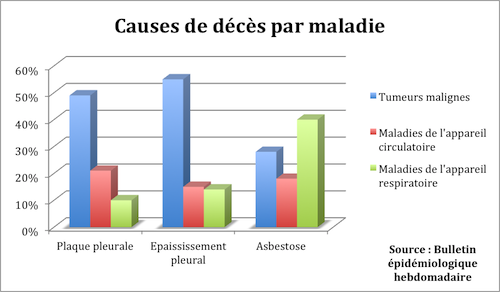It is one of the most followed health crises in France. Asbestos continues to claim victims nearly 20 years after its ban, with 2,000 cancers reported each year.

Banned since 1997, asbestos is still talked about as much. This mineral material has been widely used in industry … and its damage is still very much alive. 2,200 to 5,400 new asbestos-related cancer diagnoses are made each year. Apart from pleural mesothelioma (cancer of the pleura), these cancers mainly affect the lungs, larynx or ovaries. A thematic edition of the Weekly Epidemiological Bulletin (BEH) takes stock of asbestos victims.
The epidemic will last
In general, asbestos-related cancers are more evident in men: the sex ratio is 3.4 men for one woman over the period 2009-2011. The gap tends to narrow, but the diagnoses are accelerating. This is particularly the case with pleural mesothelioma, a rare and aggressive malignant tumor. The annual number of cases increased from 736 to 1,073 cases between 1998-2000 and 2009-2011. This increase can be explained, in part, by less underdiagnosis in women. But generally, “the estimates produced do not exclude that the epidemic continues to develop, as predicted by two other previous studies, for at least one or two decades in our country”, underlines Jean-Claude Pairon, of the Center hospitalier intercommunal de Créteil (Val-de-Marne) in an editorial.
Men most affected
This BEH recalls the gender inequality in the face of asbestos cancers. Occupational exposure is identified as a cause of mesothelioma in 92% of men and 39% of women. Female victims also develop tumors later.
If asbestos still makes people talk, it is because it still kills so much. The peak of mortality was reached in 2001 for men, in 2002 or 2007 for women, underlines the Weekly Epidemiological Bulletin. But mortality at 4 years remains high: it varies from 6 to 20% depending on the disease. Asbestosis (1) kills the most, closely followed by pleural thickening (2) and pleural plaque (3).

Construction and automotive: high-risk sectors
Retired male artisans are the most affected by the consequences of exposure to asbestos. According to a survey of 7,700 retirees from the Self-Employed Social Scheme (RSI), on average 33 years have elapsed between the first exposure and retirement. In total, 64% of the people questioned have been exposed to asbestos during their career.
The construction sector is the most affected by occupational exposure to asbestos. Logical finding, insofar as the material has been widely used as an insulator. A wide range of professions are affected, from roofers and masons to painters and plasterers.
The trade and repair of automobiles and household items is not spared. Auto mechanics are particularly at risk because changing or machining brakes is a high risk activity. In the manufacturing industry, trades related to metal are the most at risk.

(1) Asbestosis: This serious lung condition is caused by inhaling harmful particles in the workplace. Asbestos is an identified risk factor. Incurable, asbestosis is manifested by respiratory problems, and in 15% of cases severe shortness of breath and respiratory failure.
(2) Pleural thickening: Inhaled asbestos fibers can attach to the pleura, which envelops the lung. When fibrous tissue forms on the visceral pleura (stuck to the lung), it is called pleural thickening.
(3) Pleural plaque: As with pleural thickening, pleural plaque is caused by the attachment of asbestos fibers to the pleura. In this case, it is the parietal pleura (against the chest wall) that is affected.
.

















